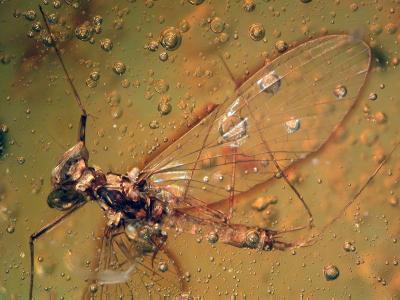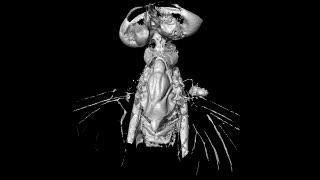A mayfly trapped in 16-million-year-old-amber reveals a hitchhiking springtail, a wingless arthropod that is amongst the most commonly found bugs all over the world. The new research, published Oct 17 in the open access journal PLOS ONE led by David Penney from the University of Manchester, UK, is the first to show that springtails travelled on winged insects like mayflies, and only the second example of this mode of travel by springtails in the past or present.
Springtails are among the most abundant group of arthropods, found in large numbers in soil all over the world. Previous research suggests that they may have spread via ocean currents or by wind as part of the aerial plankton, but traveling on another insect of a different species has not been observed in present-day springtails. Only one previous fossil preserved in amber suggests that ancient springtails may have travelled in this fashion (on a harvestman).
Mayflies can fly for no more than a few hours to a few days of their lives, and have not been seen to transport other bugs, either in fossils or in present-day studies. According to the authors, this is the first observation of such an interaction between adult mayflies and any hitchhiking organism, and the first example of springtails hitching rides on flying insects.
Lead author on the study Penney says, "This is a truly remarkable specimen. It highlights the potential for such fossils which provide snapshots of behaviours 'frozen in time' to provide clues to ecological associations occurring right under our noses today, but which may have gone unnoticed to date."

This is a photomicrograph of mayfly specimen in Miocene Dominican amber.
(Photo Credit: Penney D, McNeil A, Green DI, Bradley RS, Jepson JE, et al. (2012) Ancient EphemeropteraCollembola Symbiosis Fossilized in Amber Predicts Contemporary Phoretic Associations. PLoS ONE 7(10): e47651. doi:10.1371/journal.pone.0047651)

This is a rotating CT reconstruction of the mayfly and phoretic springtail, including a close-up 'region of interest' scan.
(Photo Credit: Penney D, McNeil A, Green DI, Bradley RS, Jepson JE, et al. (2012) Ancient EphemeropteraCollembola Symbiosis Fossilized in Amber Predicts Contemporary Phoretic Associations. PLoS ONE 7(10): e47651. doi:10.1371/journal.pone.0047651)
Source: Public Library of Science